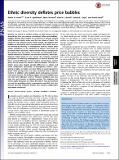| dc.contributor.author | Levine, Sheen S. | |
| dc.contributor.author | Bernard, Mark | |
| dc.contributor.author | Bartelt, Valerie L. | |
| dc.contributor.author | Zajac, Edward J. | |
| dc.contributor.author | Stark, David | |
| dc.contributor.author | Apfelbaum, Evan Paul | |
| dc.date.accessioned | 2015-05-04T16:15:40Z | |
| dc.date.available | 2015-05-04T16:15:40Z | |
| dc.date.issued | 2014-12 | |
| dc.date.submitted | 2014-04 | |
| dc.identifier.issn | 0027-8424 | |
| dc.identifier.issn | 1091-6490 | |
| dc.identifier.uri | http://hdl.handle.net/1721.1/96900 | |
| dc.description.abstract | Markets are central to modern society, so their failures can be devastating. Here, we examine a prominent failure: price bubbles. Bubbles emerge when traders err collectively in pricing, causing misfit between market prices and the true values of assets. The causes of such collective errors remain elusive. We propose that bubbles are affected by ethnic homogeneity in the market and can be thwarted by diversity. In homogenous markets, traders place undue confidence in the decisions of others. Less likely to scrutinize others’ decisions, traders are more likely to accept prices that deviate from true values. To test this, we constructed experimental markets in Southeast Asia and North America, where participants traded stocks to earn money. We randomly assigned participants to ethnically homogeneous or diverse markets. We find a marked difference: Across markets and locations, market prices fit true values 58% better in diverse markets. The effect is similar across sites, despite sizeable differences in culture and ethnic composition. Specifically, in homogenous markets, overpricing is higher as traders are more likely to accept speculative prices. Their pricing errors are more correlated than in diverse markets. In addition, when bubbles burst, homogenous markets crash more severely. The findings suggest that price bubbles arise not only from individual errors or financial conditions, but also from the social context of decision making. The evidence may inform public discussion on ethnic diversity: it may be beneficial not only for providing variety in perspectives and skills, but also because diversity facilitates friction that enhances deliberation and upends conformity. | en_US |
| dc.language.iso | en_US | |
| dc.publisher | National Academy of Sciences (U.S.) | en_US |
| dc.relation.isversionof | http://dx.doi.org/10.1073/pnas.1407301111 | en_US |
| dc.rights | Article is made available in accordance with the publisher's policy and may be subject to US copyright law. Please refer to the publisher's site for terms of use. | en_US |
| dc.source | National Academy of Sciences (U.S.) | en_US |
| dc.title | Ethnic diversity deflates price bubbles | en_US |
| dc.type | Article | en_US |
| dc.identifier.citation | Levine, Sheen S., Evan P. Apfelbaum, Mark Bernard, Valerie L. Bartelt, Edward J. Zajac, and David Stark. “Ethnic Diversity Deflates Price Bubbles.” Proceedings of the National Academy of Sciences 111, no. 52 (November 17, 2014): 18524–18529. | en_US |
| dc.contributor.department | Sloan School of Management | en_US |
| dc.contributor.mitauthor | Apfelbaum, Evan Paul | en_US |
| dc.relation.journal | Proceedings of the National Academy of Sciences | en_US |
| dc.eprint.version | Final published version | en_US |
| dc.type.uri | http://purl.org/eprint/type/JournalArticle | en_US |
| eprint.status | http://purl.org/eprint/status/PeerReviewed | en_US |
| dspace.orderedauthors | Levine, Sheen S.; Apfelbaum, Evan P.; Bernard, Mark; Bartelt, Valerie L.; Zajac, Edward J.; Stark, David | en_US |
| dc.identifier.orcid | https://orcid.org/0000-0002-1941-4700 | |
| mit.license | PUBLISHER_POLICY | en_US |
| mit.metadata.status | Complete | |
